The Withdrawal of American Men
From college, the workforce, democracy, friendships, and romance
It’s hard to get away from zero-sum thinking on gender. As if you could only wish good things for women, or men, but never both.
Ever since Trump made inroads with young male voters, particularly among Latino and Black men, the internet has been alight with commentary about the plight of boys and men. Understandably, the avalanche of attention to the struggles of men has prompted some women to say, Wait a minute, only 10% of Fortune 500 CEOs are women1, we’re losing access to abortion, and we still spend 30 minutes more per day on unpaid domestic labor than men.2
They are right. There is much more to be done — something both men and women are working to address. Fortunately, there are more than 50,000 nonprofit organizations dedicated to the well-being of women and girls. In 2021, they received over $10 billion in philanthropic support.
And they have been very effective, as reflected by the impressive gains made by women over the past few decades:
In 1970, 20% of managers were women. Today it’s over 52%.
In 1970, 10% of Ph.D.’s went to women. Today it’s more than 53%.
Two out of every three bachelor’s degrees now go to a woman, compared to one out of every three in 1970.
In 1970, only 12 members of Congress were women, and not a single governor. Today, over 150 members of Congress are women, and 13 states are led by women.
Fewer than 300,000 girls played sports in high school in 1970; today, it’s over 3.4M.
In 1972, fewer than 5% of businesses in the U.S. were owned by women. Today, it’s 40%.
That is incredible progress that we ought to celebrate more. There is still work to be done, but there’s no doubt that we’re headed in the right direction.
The Struggles of Men
But most men are not doing well. After thousands of years of unfair advantage, we are falling behind in education, the workforce, voting, friendship, and romance. I hear a surprising number of women say something like, “Well, now it’s men’s turn to see what it feels like.”
Which tells me that they were never really advocating for “gender equity.” They are gender tribalists who care about just half of the planet.
Sure, some things really are zero-sum. You can’t advocate for more women in Congress without making room by removing men.
But most things are not. You can create more jobs for men without taking jobs away from women. You can enroll more men in higher education while enrolling more women, too. You can address the decline of boys’ sports participation while girls’ participation continues to climb. Consider:
3 million prime-age men left the workforce over the past twenty years.
The share of men who say they have zero close friends increased from 3% in 1990 to 15% in 2021
Twice as many men die from drug overdose deaths than women
Men commit 4 out of every 5 suicides, and the increase has been especially stark for younger men
3 out of every 5 homeless Americans are men, and the number is increasing fast
63% of American men under 30 are single compared to just 34% of young women3
These statistics point to a consistent picture: men are withdrawing from the workforce, friendships, and relationships.
Democracy, too. For all the rhetoric about angry young men handing the election to Trump, most didn’t show up. Ever since 1980, women have voted more than men by 3 to 4%. In Washington State, young women voted more than young men by nearly 9%.
Why Men Withdraw
Brené Brown was a social work researcher when she began studying how men experience shame when they feel unneeded and unaccomplished. She came across three typical responses:
Anger – Instead of expressing vulnerability, men lash out as a way to deflect from perceived weakness.
Withdrawal – Shutting down emotionally or physically, withdrawing into silence, isolation, and emotional detachment.
Numbing – Alcohol, drugs, gambling, and screen time to avoid confronting emotions and hard conversations.
Hollywood loves to depict the first response — angry young men who don’t fit in to contemporary society. Adolescence is the most recent example, but just think of Fight Club, Joker, Unhinged, American Psycho, and Point Break.
Podcasters warn of the dangers of the manosphere, but offline, there is little evidence of angry young men. Violent crime by young men has dropped dramatically since 2005, alongside drinking, drug use, cigarette smoking, and sexual activities. Intimate partner violence has declined by nearly 70% since 1993.4
Instead, all the data points to men’s withdrawal and numbing. Feeling rejected and toxic, boys and men are spending more time on gaming, gambling, and porn while they’re at a higher risk for suicide, drug overdose, and homelessness.
There are real solutions
We can help men fare better without taking anything away from women’s progress.
Higher education — Schools can join the Higher Education Male Achievement Collaborative to learn how to recruit and retain male students, especially men of color and rural men.
Workforce — Men seem to especially benefit from apprenticeships and vocational learning to gain workforce experience. Trump’s executive order to reach and surpass a million new active apprenticeships could help.
Volunteer Recruitment — Men are constantly told it’s their time to step back. But in fact, we need men to step up as mentors, coaches, and volunteers. 66% of the youth on waiting list at Big Brothers Big Sisters of America are boys, but only 30% of volunteers are men. It’s time for a national campaign for men who serve.

The challenges faced by men require personal engagement — mentoring, coaching, men’s groups — as well as policy solutions.
Both/And
Men’s struggles over the past few decades don’t compare to the violence and oppression women have experienced for thousands of years. At the top tier of politics and the private sector, men still hold too much power. We ought to address the power imbalance at the top without ignoring the troubling retreat of most men from education, work, civic life, and human connection.
True gender equity recognizes when either gender faces systemic challenges. The withdrawal of American men isn't inevitable—it's a challenge to be addressed with the same determination that has driven decades of progress for women.
Though it is worth celebrating that women today hold 30% of Fortune 500 board seats compared to just 15% in 2016.
Amounting to some $6,400 of unpaid labor per year. While this is no bueno, we should celebrate that American men are doing more unpaid housework today than ever before.
How is this possible? Women are more likely to be in a relationship with older men.
Though depressingly, lethal intimate partner violence has not declined in recent years.




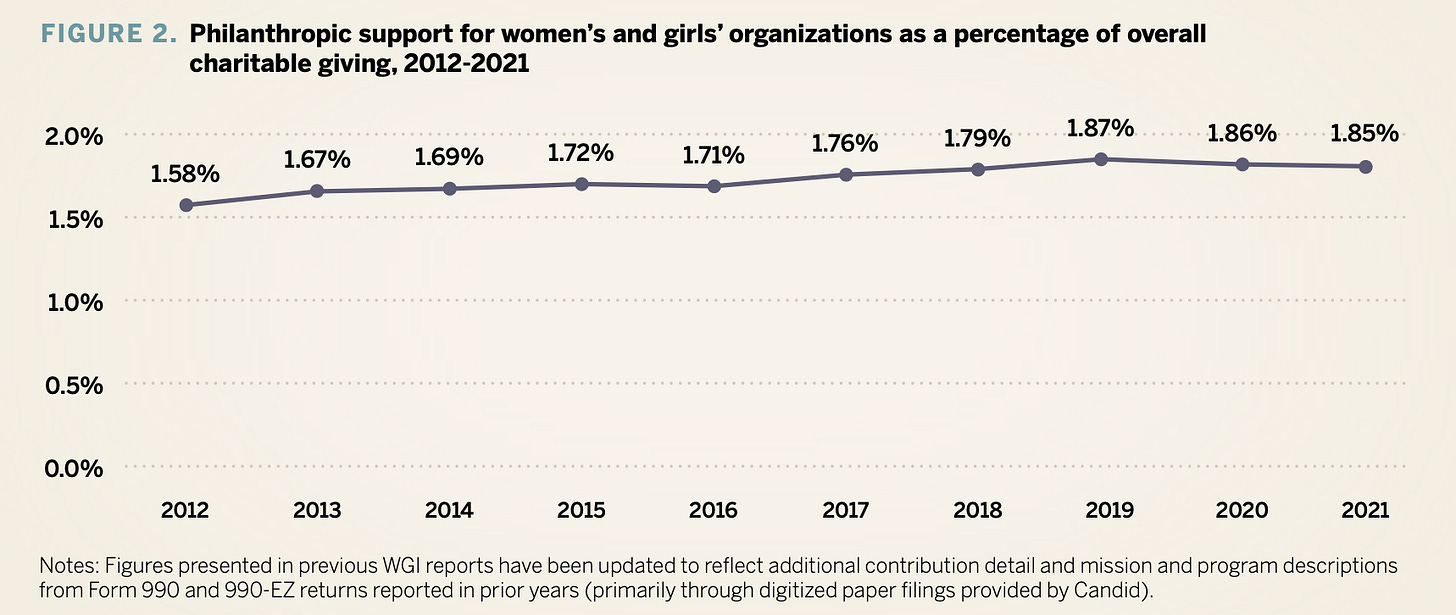
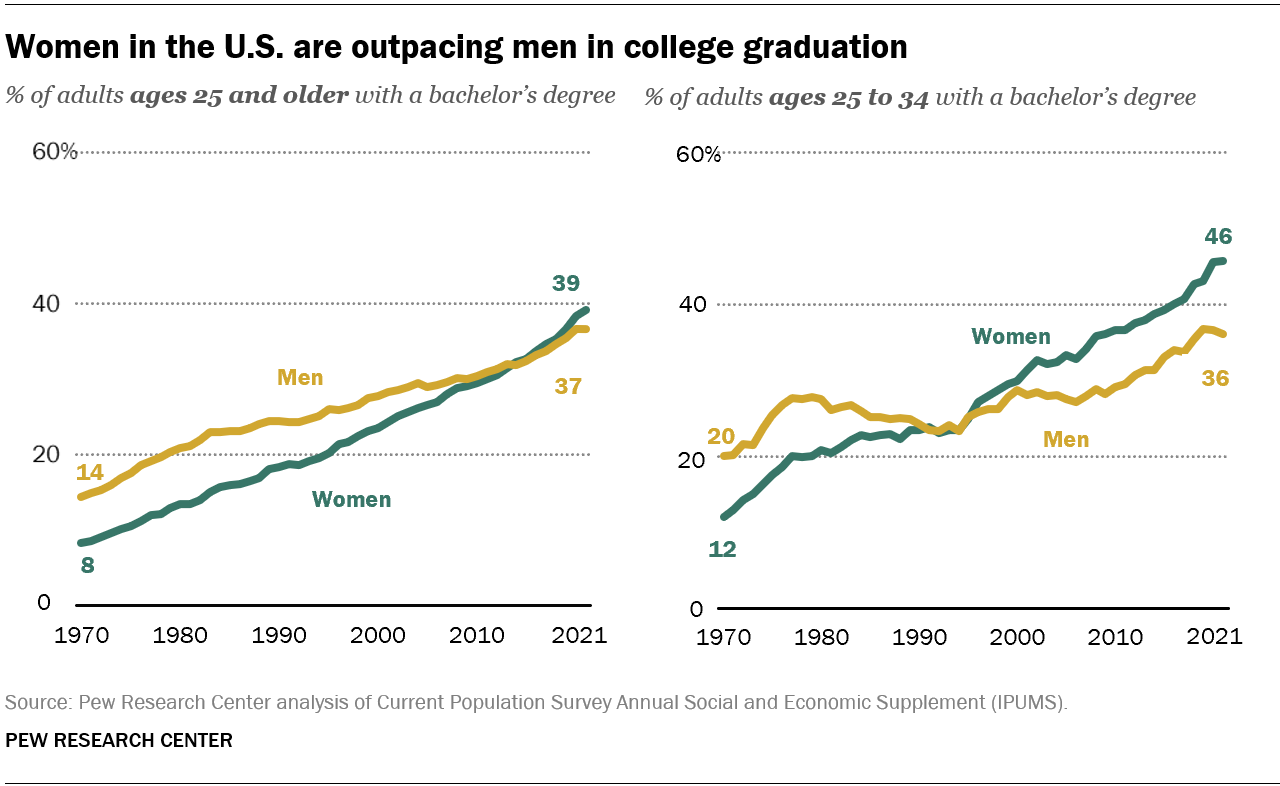
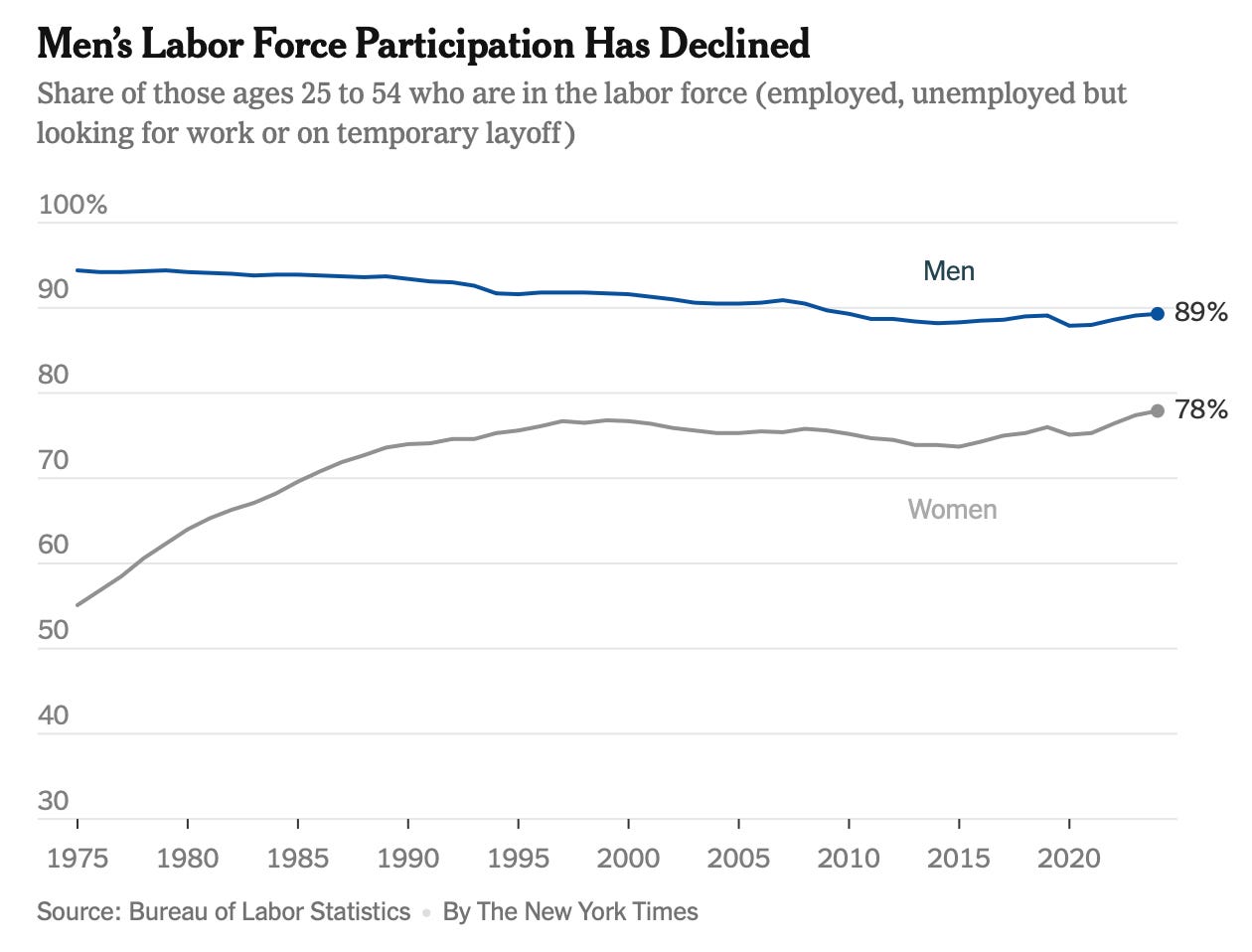
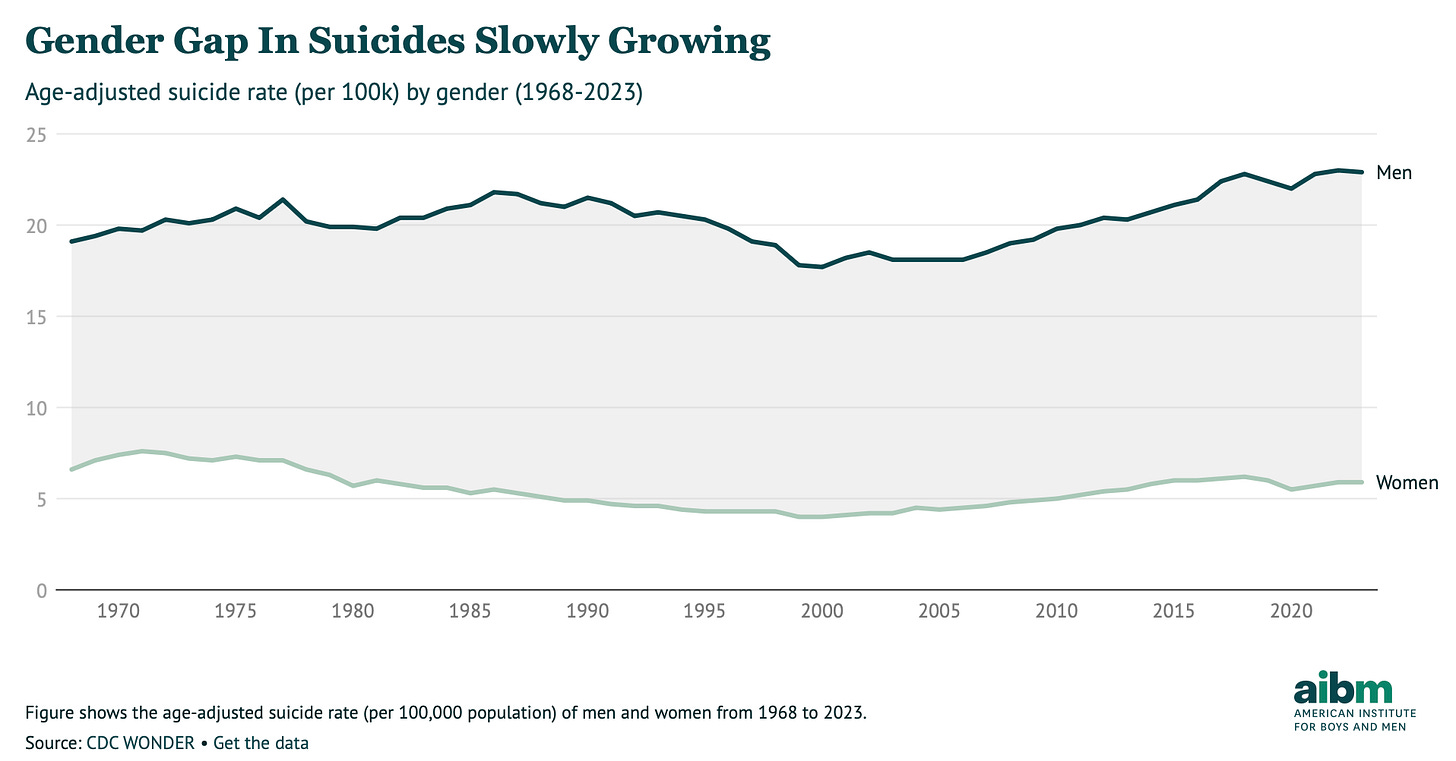
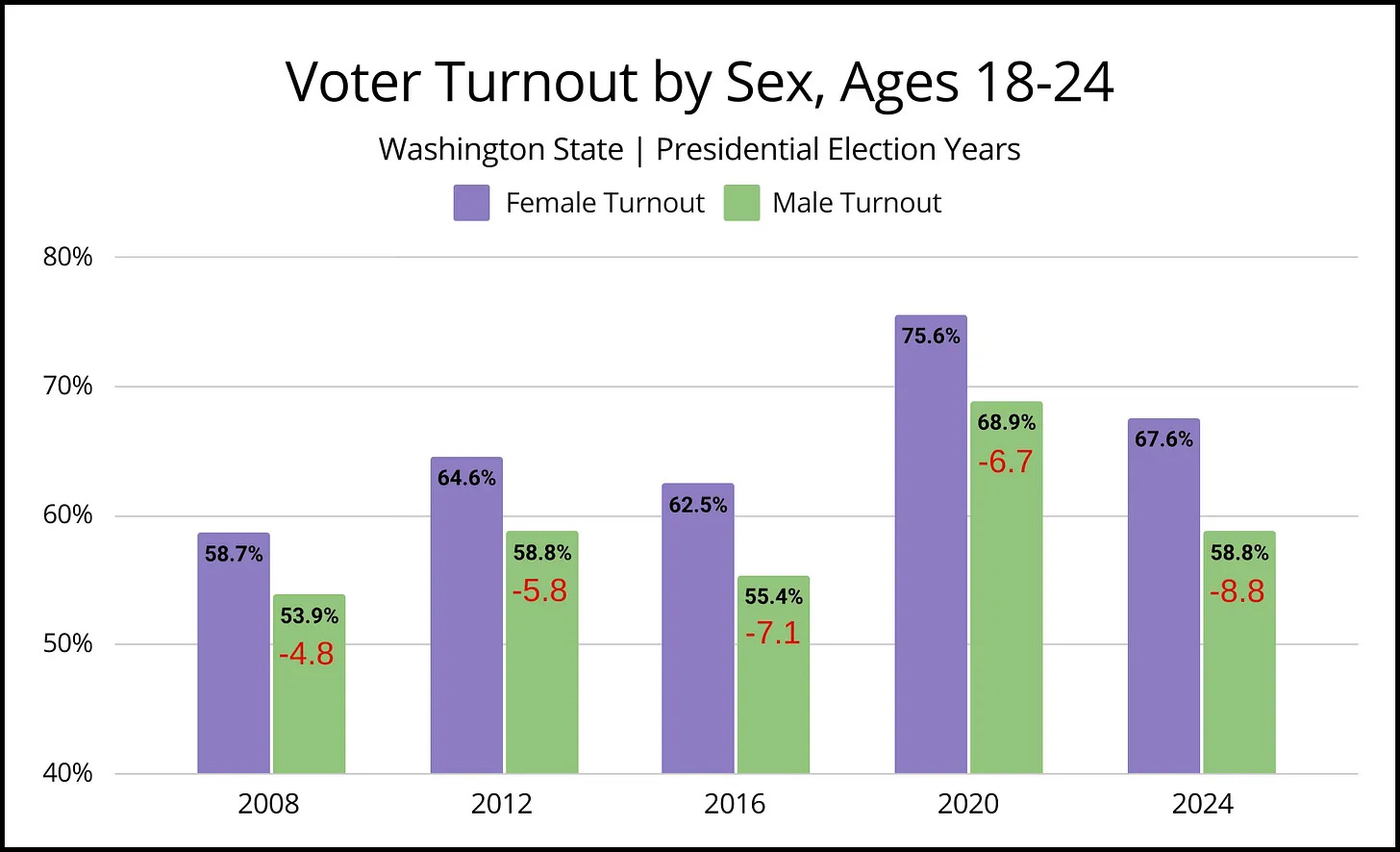
I read this a couple of days ago but couldn't articulate why I liked it. Am back because I can now, it was the perfect length for this topic and the writing flowed seamlessly into the topic and right back out. Just my experience. Carry on.
Not sure I agree on "withdrawal." From what exactly? I see a generation of men running wildly fast at something that isn't aligned to whatever you're measuring above. Military recruitment in the US is up, more men are now more religious (and that was flipped for most of the 20th century), and things like UFC have grown to 1.1bn households and 72% (SEVENTY-TWO!) are male viewers. The most profitable US sport is still football, and aside from overwhelming studies and data to say your brain is safer without it, participation numbers are steady, yet CLIMBING in college, for men.
I like your solutions but they seem unrealistic because I think there is something about role models here you're not highlighting as much. Think about college. For almost 20 years men have been fed that they can opt out of college, from Steve Jobs, Bill Gates, and Mark Zuckerberg. Men have the ego to say they don't need education, just grit, courage, and a Hot or Not product. Workforce? What's the point when you can play FanDuel all day or reach success, especially political power, by being mediocre? I think men are choosing other things, not that they are being left behind. I don't see much of a withdrawal, but a redefining of goalposts and a doubling down on raw individuality for power.